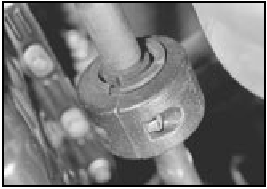
Fiat Uno Manual
DriveshaftsSupplement: Revisions and information on later models / Driveshafts
Inboard joint boots (non-Turbo
models, September 1987 on) -
modification
1 Modified boots have been fitted to the
differential ends of the driveshafts on non-
Turbo models produced after September 1987.
2 The new boots incorporate a seal/bearing assembly, and it is very important when a boot is being fitted to the driveshaft that it is located as shown in Fig. 13.96.
3 The boot retaining band must be crimped using suitable pinchers at the highest point on the boot.
Intermediate driveshaft
(Turbo ie models)
Description
4 On these models, an intermediate
driveshaft is fitted between the final drive of
the transmission and the flange of the
right-hand driveshaft.
5 A support bearing assembly for the intermediate shaft is bolted to the engine crankcase. The bearing carrier also acts as the alternator bracket.
Removal
6 Drain the transmission oil. Disconnect the
right-hand driveshaft from the intermediate
shaft flange, move the driveshaft aside, and
support it.
7 Unscrew and remove the bolts which hold the intermediate shaft retainer plate to the crankcase support bracket.
8 Withdraw the intermediate shaft from the final drive housing. The shaft assembly, complete with bearing, will pass through the crankcase support bracket until the bearing retainer and flexible boot can be slipped off the shaft.
Bearing renewal
9 The bearing on the intermediate shaft can
be renewed after removing the plate, circlip
and washer, and pressing the shaft out of the
bearing.
10 When fitting the new bearing, apply pressure only to the inner track, and do not apply any heat.
Refitting
11 This is a reversal of removal. Tighten all
bolts to the specified torque and replenish the
transmission oil.
Inboard CV joints (Turbo
ie models) - overhaul
12 A worn joint is best renewed, but it may
be necessary to dismantle it for cleaning, if
replacement of a split boot has been
neglected.
13 Disconnect the boot securing clip and pull the boot up the shaft. Wipe away the old grease.
14 Extract the joint securing circlip and pull the joint from the shaft.
15 Renew the joint complete if it is worn or damaged.
16 Before dismantling the joint, align the housing and ball cage marks “A” and “B” (Fig. 13.100).
17 Tap the joint from its backplate.
18 Turn the ball/cage assembly through 90º, mark its relative position to the outer track and withdraw it (photo).

13.18 Removing inboard CV joint ball/cage assembly from outer track
19 The balls are a light snap fit in the cage.
Once they are removed, the inner and outer cage members can be separated; again, mark the side of the cages in relation to the outer track (photos).

13.19A CV joint balls and cage

13.19B Separating inner and outer cage members

13.19C Components of CV joint
20 When reassembling, pack the joint with special FIAT Tutela MRM2 lubricant; if this is not available, use molybdenum disulphide grease.
21 The reference groove on the outer track must be assembled so that it is towards the final drive when refitted (photo).

13.21 Outer track reference groove
22 Pack the joint and the inside of the boot liberally with the specified grease.
23 If a new joint is being fitted to the shaft, make sure that the joint and shaft colour codes match.
Shaft colour Joint colour
Blue Blue or white
Red Red or white
Right-hand driveshaft damper
weight (1108 cc and
1372 cc ie models) -
removal and refitting
24 A damper weight is fitted to the longer,
right-hand driveshaft to reduce vibration (photo).

13.24 Right-hand driveshaft damper weight
25 It should not be necessary to remove the damper weight unless the driveshaft is to be renewed, or the weight has been damaged.
26 The weight is in two halves, and can be removed by simply unscrewing the two clamp bolts securing the two halves to the driveshaft. Note that the weight locates on a rubber mounting which is split along its length, and can simply be pulled from the driveshaft for renewal if necessary.
27 Refitting is a reversal of removal, but ensure that the damper weight is positioned exactly as shown in Fig. 13.101.

Fig. 13.96 Driveshaft boot positioning diagram - later non-Turbo models (Sec
13)
Left-hand shaft
With 4-speed transmission,
A = 143.0 mm (5.63 in)
With 5-speed transmission,
A = 133.0 mm (5.24 in)
Right-hand shaft
With 4-speed transmission,
A = 123.0 mm (4.84 in)
With 5-speed transmission,
A = 108.9 mm (4.25 in)
B = 0 to 1 mm (0 to 0.04 in)

Fig. 13.97 Crimping the driveshaft boot securing band (Sec 13)

Fig. 13.98 Components of the intermediate driveshaft - Turbo ie models (Sec
13)
1 Bearing retaining plate
2 Ball bearing
3 Wave washer
4 Circlip
5 Bearing cap

Fig. 13.99 Extracting the CV joint circlip - Turbo ie models (Sec 13)

Fig. 13.100 CV joint housing and ball cage alignment marks (A and B) - Turbo
ie models (Sec 13)

Fig. 13.101 Correct position of driveshaft damper weight on 1108 cc and 1372
cc ie models (Sec 13)
Dimensions in mm






